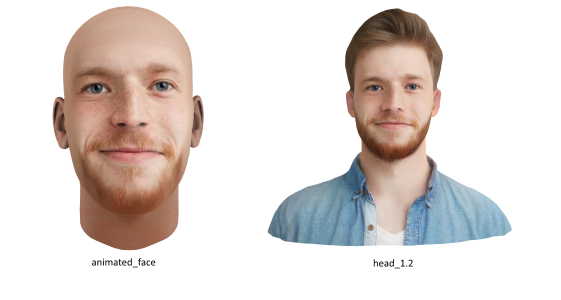 |
Avatar SDK Offline Unity plugin
1.9.1
animted_face and head_1.2 pipelines
|
 |
Avatar SDK Offline Unity plugin
1.9.1
animted_face and head_1.2 pipelines
|
Avatar SDK Offline plugin generates avatars locally on a client device. Internet connection is used only to log the number of avatars to the Avatar SDK cloud. It tries to connect to our server each time before the avatar calculation.
The plugin is available starting from the Pro subscription plan.
Latest version is 1.9.1.1: Download
Older Releases
Website: https://avatarsdk.com
Support email: support@avatarsdk.com
This version of the SDK supports Animated Face and Head 1.2 pipelines. Head 2.0 are available in the separate package.

This section will be updated in each version. Last updated: 1.9.1
"Offline" avatar generation currently works on Windows, Android, iOS and MacOSX. Minimal requirement is 2Gb+ of free RAM.
The most of this package take binary resources required to compute avatar directly on the client device and generate hairstyles and blendshapes. These resources are quite heavy. You may consider Cloud SDK version which is really lightweight and works on all devices, even in WebGL.
Offline SDK brings all the resources (blendshapes, haircuts) with it for both Head_1.2 and Animated Face pipelines. Total size of the resources is 265 mb. Animated Face resources take 122 mb. It includes haircuts - 77 mb, and blendshapes - 23 mb. Head 1.2 resources take 142 mb. Blendshapes take 27 mb of this number.
For example, if you don't need the "female_NewSea_J086f" haircut, you can delete the directory contains resources of this haircut: "Assets/avatar_sdk/sdk_offline/resources/bin/face_resources/haircuts/female_NewSea_J086f". This way, you can delete the "Assets/avatar_sdk/sdk_offline/resources/bin/face_resoirces/haircuts" directory if you are not going to use haircuts at all. The same works for blendshapes sets.
Another solution: you can omit including the binary resources into the package. Instead of it the resources are stored somewhere on the server and the client application downloads them before calculating the first avatar.
See this guide on how to store resources on a server.
If you need to generated a fullbody avatar, please, consider the Cloud version of the Avatar SDK. Offline version doesn't support it.
This version contains only the legacy fullbody sample where the avatar is attached to the headless body. You can find this sample in the "Assets\itseez3d\avatar_sdk\samples_offline\03_fullbody_sample_offline\" directory. Please note that it's just an example of how this can be done in the real app, and the low resolution character provided is just a placeholder, you should replace it with your own body models. This method works for any humanoid rig, but of course, you will have the seam between the neck and the rest of the body, which should be covered with some kind of collar. If you have questions about this feature or you need more advanced functionality (like the seamless attachment to your bodies with texture blending), please contact us at support@itseez3d.com For now, you're encouraged to take apart this sample to see how it works. See the detailed instruction on the Fullbody Sample documentation page.
Such error happens when the native library can't be found. Most often reason is invalid target platform in the Build Settings.
Error code 14 means that there are not enough free RAM memory on the device for avatar processing.
Most often this error happens during Head 1.2 avatar generation on Android when the 32-bit application is run on the 64-bit device. Our advice is always use the 64-bit (arm64-v8a) build for Android.
Yes, the limit of the avatar generation depends on your subscription plan: Avatar SDK pricing. Offline version of the plugin calculates avatars locally but it reports the number of generated avatars to the cloud.
Yes, we provide 30-day trial for the Pro subscription plan: https://accounts.avatarsdk.com/subscription/
Yes, the plugin works in runtime. Any player of your game can generate his avatar.
9 LODs supported ranging from ~3K to ~24K triangles per avatar for the Animated Face pipeline.
8 LODs supported ranging from ~5K to ~50K triangles per avatar for the Head 1.2 pipeline.
Please see the scene documentation for the Parameters Sample scene.
Animated Face pipeline supports "cartoonish" avatars. These avatars differ from the regular by the modified geometry and specific textures. "Cartoonish" Head 1.2 avatars don't support geometry modification, only the texture. See the Cartoonish Sample for details.
The SDK is pretty robust, but these recommendations will improve the quality (in priority order): Our recommendations:
Unfortunately, Unity does not provide a consistent mechanism for plugin upgrades, so the most failproof method is to delete the avatar_sdk folder from your project entirely and re-import the entire plugin. If you have changes in SDK source files (this is not recommended and you should try to avoid this, but sometimes it's inevitable), then you can use diff tool like Meld to manually merge your changes to the new version of the plugin. After upgrading it's highly recommended to re-enter your authentication credentials in Window->itSeez3D Avatar SDK->Authentication and press Save Credentials ...
Any questions about the plugin or the avatar generation, general feedback, bugs, ideas, feature requests: support@avatarsdk.com.
For commercial inquiries or licensing questions use business_support@itseez3d.com or support@avatarsdk.com